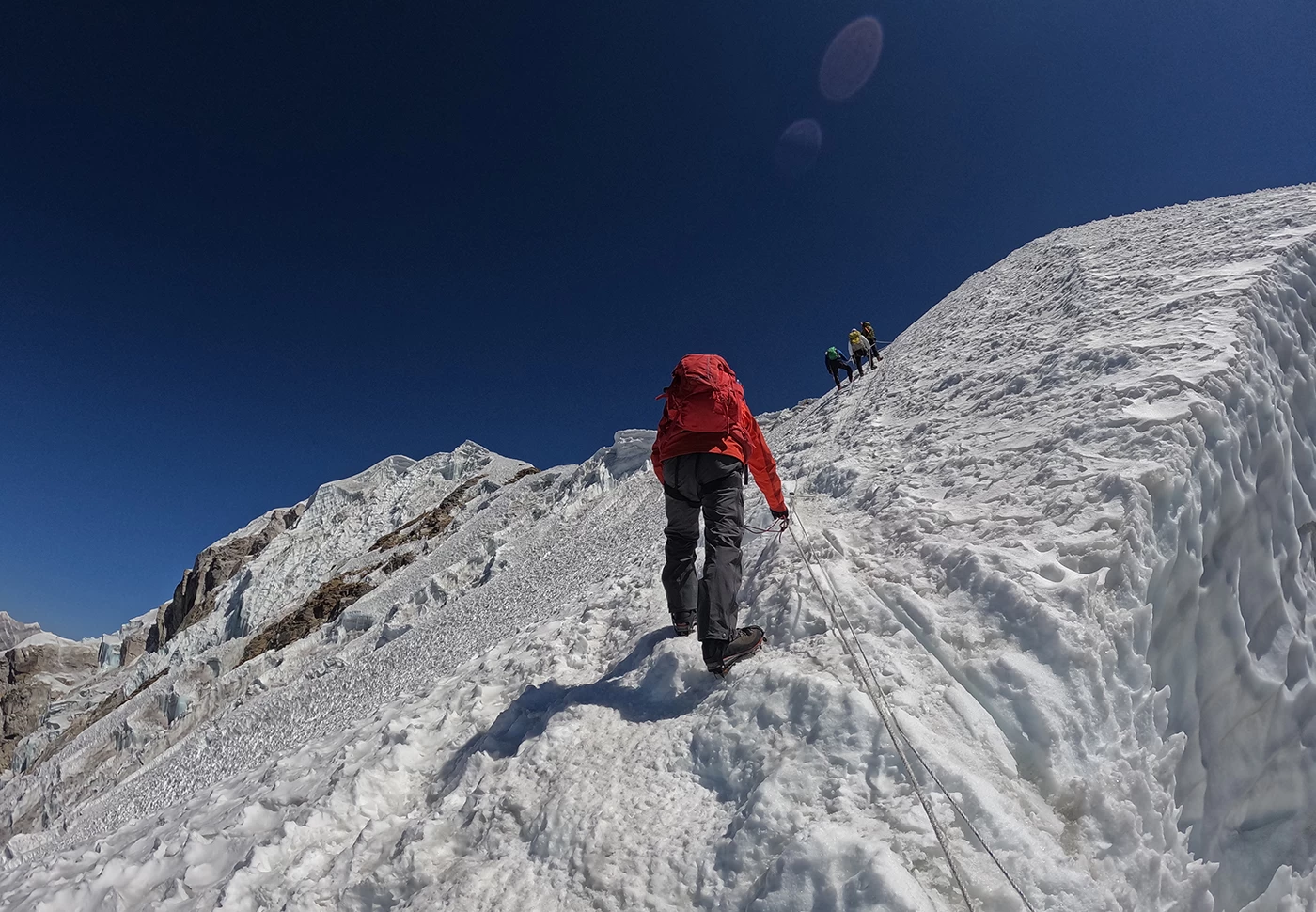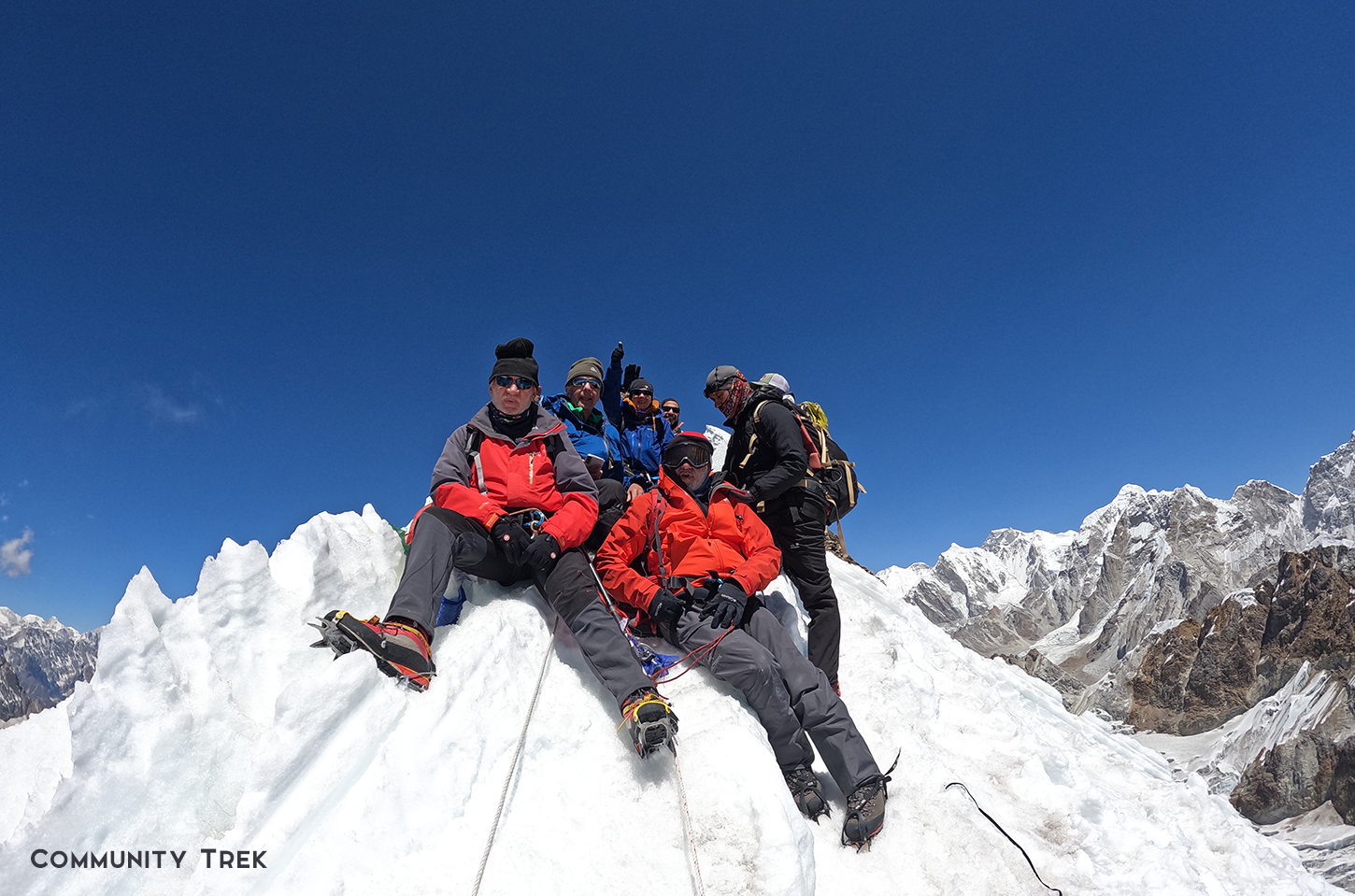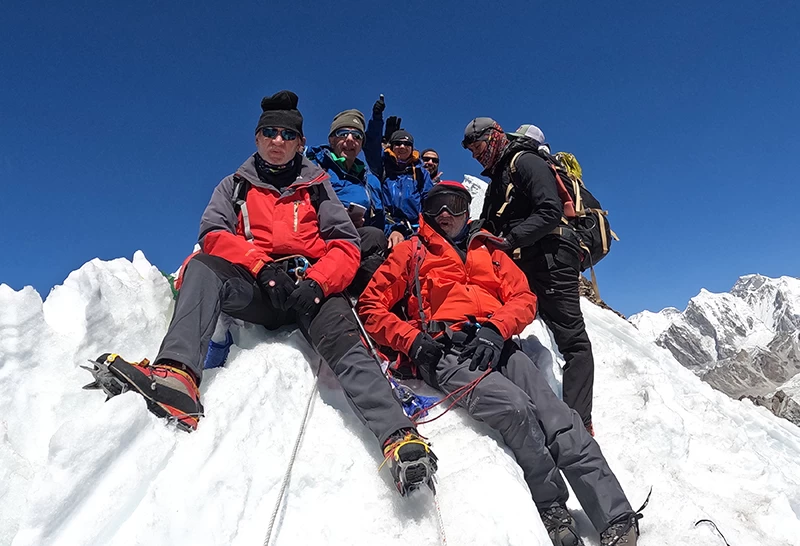

Lobuche East is one of the trekking peaks in Nepal that is open for climbing. It is located above the Lobuche village, which is a day camp on the classical trail to Gorekshep and Everest Base Camp. Lobuche has two summits, east and west, with heights of 6,119 meters and 6,145 meters, respectively. We will summit the east summit during our expedition.

Among the trekking peaks in Nepal, Lobuche East is one of the most technical to climb, even though it is only 6,119 meters above sea level. Lobuche East climbing requires excellent use of expedition-style ropework (main and fixed ropes). Climbers must also be comfortable with some scrambling and slippery rock slabs and snow slopes to reach the southwest ridge, which is just below the glacier and near the high camp. The final expedition climb is a sharp and exposed ridge that leads to the summit. Depending on the season, the summit climb may require climbing at an angle of 70 to 75 degrees with some belayed snow or ice climbing, making it a very demanding climb.
You must be comfortable with basic rock climbing and have a basic knowledge of alpine climbing techniques, including rope climbing, using an ice axe and crampons, and abseiling.

Unique Challenge: While not the highest peak, Lobuche East packs a punch with its steep slopes, exposed ridges, and potential for snow and ice climbing. It's a perfect stepping stone for aspiring mountaineers looking to graduate from trekking peaks.
Stunning Views: From the summit, you'll be rewarded with panoramic vistas of the Khumbu Valley, including giants like Everest, Lhotse, and Nuptse. Imagine capturing these breathtaking views with your camera!
Accessibility: Located near the popular Everest Base Camp trek, Lobuche East can be easily incorporated into your existing Himalayan adventure.

Technical Climb: Be prepared for some scrambling, slippery rock slabs, and snow slopes leading to the southwest ridge. The final summit push involves a steep, exposed ridge with potential for snow and ice climbing, requiring proper skills and equipment.
Ropework Expertise: Lobuche East demands good ropework skills using both main and fixed ropes. Ensure you're comfortable with belaying, rappelling, and other essential rope techniques.
Physical Fitness: This is not a walk in the park! You'll need good cardiovascular endurance and leg strength to navigate the challenging terrain.

Train for altitude: Acclimatization is crucial for success at high altitudes. Gradually increase your elevation over several days before attempting the summit.
Sharpen your skills: Brush up on basic rock climbing, ice axe and crampon usage, and abseiling techniques before your trip.
Choose the right gear: Invest in proper mountaineering clothing, footwear, and equipment to stay safe and comfortable in the harsh Himalayan environment.
Lobuche East is a rewarding challenge for experienced climbers seeking an unforgettable adventure in the heart of the Himalayas. With careful preparation, the right skills, and a spirit of determination, you can conquer this iconic peak and stand atop the world.

Remember: Climbing Lobuche East requires proper planning, training, and guidance. Always consult with experienced mountaineering professionals before attempting this climb.
|
|
|
|---|
Upon your arrival at the TIA, one of our representatives will be waiting to welcome you. After the meet and greet, you will be transferred to the hotel booked for you to rest. There you will freshen up and we will see you in the evening for the welcome dinner at a typical Nepali Restaurant. Our trip starts immediately on the next day, so we suggest you segregate your travel items in a separate bag from your luggage.
From Phakding, you follow the Dudh Kosi north through magnificent forests with glimpses of the mountains ahead. You cross the river several times by bridge as you pass through the villages of Benkar, Monzo, and Jorsale. A final bridge brings you to the foot of the steep climb to Namche Bazaar. Halfway up the ascent, you may get your first glimpse (cloud permitting) of the Everest summit behind the great ridge of Nuptse-Lhotse. A last 985ft (300m) climb brings you to Namche Bazaar, the Sherpa capital and the main town in the area.
It is time to acclimatize in Namche Bazaar. Namche Bazaar is a bustling town with many wifi-linked cafes and restaurants, souvenir shops, and gear shops. You can explore the town and do some shopping, or you can go on one of the many hiking trails in the area. Some popular hiking destinations include Hillary School, Sherpa Settlement, Syangboche Airport, and Yak Farms. If you are passionate about Everest, you should not miss hiking up to Everest View Hotel, which offers breathtaking views of Mount Everest.
Today is a special day as you’ll veer off the beaten track and away from the hustle and bustle of the trails as we make our way to the beautiful, traditional village of Phortse. On your way to Phortse, you will walk through pine forests, past stupas, and enjoy breathtaking views of some of the Himalaya’s highest peaks. In Phortse, you can learn about the lives of the Sherpa people. Many Everest summiteers live in Phortse, and it is also home to the oldest monastery in the Khumbu region and to the remains of a yeti.
Today, the landscape changes dramatically as we trek through mossy forests, cross the Imja River, and pass more intricate Buddhist Mani stones. We climb upwards to Dingboche, where you will feel so close to the Himalayas with Ama Dablam looking down upon you. This is around the time in our journey where you might begin to feel the effects of the altitude, but that's normal. Our guides will be looking out for you and making sure that you are staying hydrated.
Today is your acclimatization day in Dingboche. You have the opportunity to climb Nangkartshang Peak (16,730 ft/5,100 m) and enjoy breathtaking views of Makalu, Lhotse, Chalotse, Tawoche, and Ama Dablam. If you are acclimatizing well to the altitude, you can attempt the tough and steep climb to the top, which takes around 3 hours and 30 minutes. Alternatively, you can climb halfway up if you are feeling less energetic. Despite the challenging climb, the incredible views make it all worthwhile. After your descent, you will return to Dingboche for a late lunch and have the rest of the afternoon to relax and acclimatize.
The trail climbs steeply out of Dingboche, past a chorten, and ascends the valley gradually to Thukla at the end of the terminal moraine of the Khumbu Glacier. We stop here for a tea break and snack before the steep climb to Thukla Pass, a beautiful and poignant place with a line of memorials to climbers who have died on Everest. From Thukla Pass, we can enjoy a beautiful panorama of the peaks on the Nepal-Tibet border. The trail then eases off as we follow the valley to Lobuje, a tiny hamlet with a few teahouses. In the late afternoon, there is the option to walk up onto the lateral moraine of the Khumbu Glacier. The sunset on Nuptse is not to be missed.
We will then slowly move up towards Lobuche Peak Glacier Camp through rugged and rough terrain. As we cross the Lobuche Glacier and move forward through the challenging path, we reach the Lobuche Base Camp where we will practice some climbing with our gear and equipment. On this day, we will stay overnight in a foolproof tent so that we can move early the next day for our summit. We will have two climbers in one mountain tent with separate kitchen, dining, and bathroom tents.
As we will have gained significant elevation, the chances of altitude sickness are high. We suggest you keep communicating with each other and walk slowly at a maintained pace.
We wake up shortly after midnight and prepare to head for the summit as the views look mesmerizingly beautiful and clear during the early morning. After hours of ascent on snow, ice, and rocks, we finally reach the summit of Lobuche East Peak. We take a moment to admire the scenic beauty of the Khumbu Region.
The panoramic views of Mt. Everest, Nuptse, Lhotse, Ama Dablam, Pumori, Cholatse, and other peaks are simply breathtaking. After some amazing photoshoots, we trek back to our destination for the day, Thukla/Dughla, a small settlement at the endpoint of Khumbu Glacier, which is also called the memorial point as it owns numerous memorial structures in the memory of those who lost their lives in the Khumbu region. We set up a tented camp at Thukla to rest overnight.
The day is allocated for contingencies like bad weather, health conditions, and other unforeseeable events.
The day is allocated for contingencies like bad weather, health conditions, and other unforeseeable events.
After a successful summit and trek back to Thukla, we then move towards Tengbuche, which is located in the Tengboche village of the Khumbu region at an elevation of 3,867 meters/12,687 ft. Tengboche Monastery is the largest gompa in the Khumbu region.
On this day, our trek begins from Tengbuche to Namche after early morning breakfast. The trail is gorgeously overwhelming as it takes us through the Rhododendron Forests, Alpine trees of pine, and Junipers. Further ahead, we cross the Dudh Koshi River and follow the gorge through dense coniferous forest. Traveling along a steep rugged path up and down and twisting on numerous curves, we finally reach Namche Bazaar, the Sherpa Capital to rest overnight.
After breakfast in Namche Bazaar, descend to the famous Hillary Bridge and continue walking to Manju, Phakding, and Lukla.
Today is your last night in the mountains, and it is customary to have a small party with all your trekking crew and members. You can offer some drinks and food for your hardworking crew to make the last evening more memorable for the entire team. You can also express your gratitude to all crew members with some tips, which will make them happier and bring you a different kind of happiness.
During the spring and April, the return from Lukla will fly back to Manthali on one of the first flights of the day (approximately 7-7:30 am) to allow for the 5-6 hour bus transfer back to Kathmandu arriving in the city for the mid-late afternoon.
Today marks your final day with Community Trek, and we hope your time in Nepal has been filled with incredible memories. After a delicious breakfast, you'll be free from our program to explore independently, pursue any remaining interests, or simply relax and reflect on your unforgettable journey.


| Departure | Return | Duration | Price From |
|---|
500 US $ Deposit: Secure your spot with a minimum deposit. Remaining Payment: Pay anytime before the trip starts.
You can cancel anytime. Get a full refund up to 40 days before your trip. 50% refund up to 25 days before. 25% refund up to 15 days before. No refund after 15 days or after the trip starts.
Lobuche Peak is considered a challenging technical climb. It requires experience with scrambling, ropework, ice axe and crampon usage, and potentially navigating steep snow and ice slopes. While not the highest peak, its technical terrain and exposure make it a demanding climb for experienced climbers.
The best seasons for climbing Lobuche Peak are spring (April-May) and autumn (September-November). These months offer generally stable weather with clear skies and moderate temperatures.
Spring: Warmer temperatures but higher chances of snow and ice on the summit.
Autumn: Clearer skies and more stable conditions but colder temperatures.
There is no single "typical" itinerary for Lobuche Peak climbing, as several factors can influence the route and timeline. However, most expeditions follow a general structure:
Acclimatization: Spend several days trekking at lower altitudes in the Khumbu Valley to acclimatize to the high altitude. This often includes trekking to Everest Base Camp.
Approach: Hike to the base camp of Lobuche Peak.
Summit push: Attempt the summit climb, which typically involves technical climbing on steep slopes and ridges.
Descent: Return safely to base camp and continue trekking out of the Khumbu Valley.
Lobuche Peak climbing requires good cardiovascular endurance and leg strength. You will be hiking for long distances at high altitudes, carrying your backpack, and navigating challenging terrain. Regular physical training, including cardio and strength exercises, is essential to prepare your body for the demands of the climb.
Climbing Lobuche Peak with a qualified guide is highly recommended, especially for first-time climbers. A guide will have extensive experience with the mountain, the route, and the local conditions. They can provide essential safety and technical expertise, assist with navigation and route finding, and offer valuable advice and support throughout the climb.
You will need high-quality mountaineering clothing, footwear, and equipment for Lobuche Peak climbing. This includes items like:
The costs of climbing Lobuche Peak can vary depending on factors like the length of your expedition, the services you choose, and the season. However, you can expect to pay for:
Like any high-altitude climb, Lobuche Peak presents certain risks, including:
It is crucial to be aware of these risks and take appropriate precautions to minimize them.
If you have any further questions about Lobuche Peak climbing, feel free to consult with a reputable trekking and climbing company or a qualified mountaineering guide. They can provide you with personalized advice and information based on your specific needs and experience.
Remember, climbing Lobuche Peak is a challenging but rewarding experience. By being well-prepared, informed, and aware of the risks, you can increase your chances of a safe and successful summit.

My team successfully summited Labuche Peak in 2019, and Team Ramesh proved to be exceptionally professional. They not only organized everything for us but also ensured our safety during the climb. Some of our team members were first-time climbers in the high Himalayas, and they reached the summit of Labuche Peak without any problems. We extend our heartfelt thanks to Team Ramesh for turning our team's dream into reality. If anyone loves to climb Labuche Peak and other mountains, we highly recommend Team Ramesh with a five-star rating.
Write Your Review
Give Review